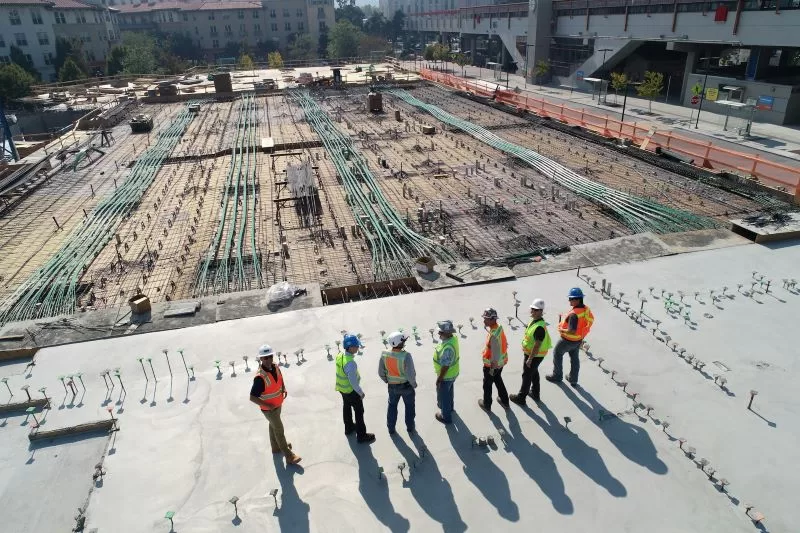In the fast-paced world of construction, the potential for legal liabilities to arise is ever-present. From contractual disputes to regulatory violations, understanding and managing the risks involved during a project not only ensures a successful outcome, but also prevents additional costs, reputational damage and other unwanted consequences which could delay or derail a project. In this article, we will explore the various legal risks associated with construction, helping project managers better navigate each risk and mitigate their liability.
Contractual Disputes
Construction projects typically involve contractual agreements with several different parties. This can include contractors, subcontractors, architects, engineers and more. Each of these working relationships requires the fulfillment of certain obligations as specified in their contract, however, when these are breached or disputes arise between the parties the issue may end up being litigated in court.
These disputes could occur for various reasons such as disagreements over the scope or quality of the work, payment issues, cost overruns, or missed deadlines. A well-drafted contract that clearly outlines all eventualities, as well as the rights and responsibilities of each party, can greatly reduce the likelihood of contractual disputes arising.
Negligence
Construction sites are hazardous places where accidents can easily occur that would present legal risks. The Bureau of Labor Statistics (BLS) reports that in 2021, nearly one in five workplace deaths occurred in the construction industry, mainly due to falls, slips and trips.
When an individual is injured on a construction site, the party responsible for the site may face a negligence claim. This could be the case where they are found to owe a duty of care toward the injured party and failed to meet this duty in some way. For example, a subcontractor on a building site may suffer an injury due to inadequate instructions or safety measures from their superior, placing them in a hazardous situation.
The result could be a costly personal injury claim where the responsible party is ordered to pay damages to the other party compensating them for matters such as medical expenses, lost wages, and future loss of earnings.
In cases of gross negligence that result in another person’s death, those responsible for the project may face criminal charges. For instance, a violation under the Occupational Safety and Health Administration (OSHA) rules, regarding project site safety could result in a charge of manslaughter. If you would like legal advice regarding a criminal charge, speak to an experienced attorney such as this Purser Law criminal lawyer who can advise you of your rights.
Insurance and Indemnity Issues
The various parties engaged on a construction project will typically have their own insurance coverage in place. This may include policies like workers’ compensation insurance, professional liability insurance, and builder’s risk insurance. The potential for a dispute to arise in connection with an insurance policy is also common during a project. This may be disagreements about whether a particular claim is covered by an insurance policy, disputes over the amount of coverage available, or conflicts regarding the party responsible for covering a claim.
Insurance policies may also provide cover for the policyholder’s indemnity obligations under their contract with another construction party. For example, a construction contract may contain an indemnity clause that requires a contractor to indemnify the project owner for any claims related to personal injury caused by their work.
Indemnity insurance would cover the contractor in the event that they have to pay out under the indemnity clause in their contract. However, problems may arise when a party seeks indemnification for their losses from another party. This could be where multiple parties are involved and responsibility for indemnification is disputed or where the indemnification amount claimed is in dispute.
To prevent such issues from arising, the drafting of insurance and indemnity clauses should be clear and comprehensive, outlining coverage amounts, the responsibilities of each party and the channels of communication to be followed to resolve such issues speedily and efficiently.
Regulatory Violations
When undertaking a construction project, there are many areas where regulatory compliance is essential including zoning laws, building codes, obtaining permits and following environmental regulations. Legal compliance may be at federal, state or local levels and regulatory violations may result in hefty fines, project delays and legal repercussions.
One of the ways contractors can ensure compliance with these regulations is through the use of compliance management software. This can help track various regulatory requirements, alert contractors of any changes they need to be aware of, and help them manage their responsibilities in an efficient and timely manner.
While there are many potential legal risks involved with a construction project, an awareness and understanding of these can help those in charge of such projects mitigate these risks and ensure a safe and successful outcome.

